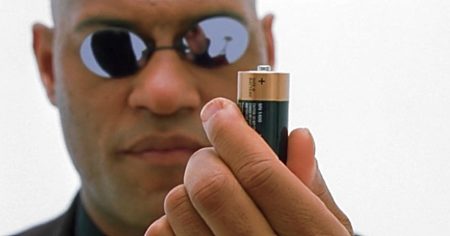The resistant-bacteria look, best opioid treatment, human-powered anti-virus clothing, and more
19 Mar 2022
Posted by Andrew Kantor
Lithium vs dementia
A new weapon in the never-ending fight against dementia: lithium. Everyone’s favorite mood stabilizer seems to reduce a person’s chance of a dementia diagnosis — that’s according to British researchers looking at the health records of 30,000 people.
For the group that had received lithium, 53, or 9.7%, were diagnosed with dementia. For the group that had not received lithium, 3,244, or 11.2%, were diagnosed with dementia.
There are limitations, of course (e.g., the small number of patients taking lithium), but the data are encouraging. Not only might lithium might reduce overall dementia risk, but “it’s possible that lithium might reduce the risk of dementia in people with bipolar disorder.”
Unexpected bipolar treatment
Fecal transplants. Aussie researchers have found they can tweak the gut biome (the deep state of the body) using fecal microbiota transplants (FMTs) — and twice now they’ve cured, or at least significantly treated — bipolar disorder.
In the study detailing the most recent case, they found that after the transplant, “there was a distinct improvement in mood oscillations, anxiety, and in putative ADHD symptoms, seemingly independent conditions.”
For a man who had required extensive and extended medications to have his bipolar condition largely remit following FMT with no need for maintenance medication, such a case is quite striking.
Link above is to the paper; click here for the news story.
Put on your dancin’ shoes!
Every convention’s band is better than the last, and this year is no exception. Cranking up the volume and making even the most grumpy old stodge dance dance dance* will be the Blues Factor Band! Blues, rock, Motown, country, funk, R&B … it’s gonna be a-frickin’-mazing.
Check ’em out:

Haven’t registered yet? What’re you waiting for?
June 9-12, 2022 Room block closes on May 18. Sign up today!
* Set your pacemaker to 11.
Does this membrane make me look drug resistant?
You can tell when a bacteria is drug resistant when, well, a drug stops working on it. But there seems to be an easier way: Look at it.
Instead of trying to tease out genetic changes in bacteria, Japanese microbiologists found an easier, 21st century way. Throwing an electron microscope and some machine learning at the problem, they discovered that resistant bacteria look different.
For example:
“We found that the bacteria that were resistant to an antibiotic called enoxacin exhibited differences in cell shape, outer membrane structure, periplasmic space, and granule content and location compared with the drug-sensitive strain.”
Now knowing that resistant bacteria “flaunt their new power” this way, they’re hoping to turn it into a technology that can automatically predict drug resistance with just a peek or two.
You don’t say
WSJ: “Ivermectin Didn’t Reduce Covid-19 Hospitalizations in Largest Trial to Date”
Human batteries and electric clothing
When you’re worried that a mask doesn’t do quite enough to keep viruses away, a group of Korean engineers and virologist have the Next Big Thing in fashion: a virus-blocking textile (VBT) — i.e., clothing that repels viruses.
Good masks use electrostatics, not just tiny holes, to keep viruses away. SARS-CoV-2, for example, has a negative charge, so it’s repelled by another negative charge, like two divas in an opera. The new fabric takes advantage of this, getting power from the person wearing it via the triboelectric effect — i.e., electricity from rubbing two things together, like a balloon on Junior’s hair.
Once they had the fabric and the human batteries working, they tested the result and found…
…that VBT can effectively repulse SARS-CoV-2 aerosols, resulting in 99.95% of SARS-CoV-2 blocked. Finally, high breathability, washability, and durability of VBT were demonstrated, and this suggests that practical application of VBT as an effective face mask or filter is enabled.

Quick drug-cost facts
Specialty drugs account for a huge chunk of drug spending in the U.S., and two categories make up the vast majority (89%) of specialty drugs: Treatment for autoimmune diseases and for asthma/atopic dermatitis, according to data from CVS.
Of note: The high overall cost, the company claims, isn’t from higher prices, but from “increased utilization.”
Opioid-abuse treatment cage match
There are three major drugs used to treat opioid-use disorder*, but which works best? There hasn’t been a study to figure that out … until now.
Analyzing data from 82,000 Medicaid claims in Ohio, researchers from Case Western Reserve, Indiana University, and an Ohio State University found that (spoiler alert!) …
[O]verwhelmingly, methadone was associated with the lowest risk of treatment discontinuation, followed by buprenorphine, then naltrexone.
Oh, and you can step it up a notch, too: “Researchers also found that medication-assisted treatment, coupled with behavioral health therapy such as counseling, increased success in patient retention.”
* Buprenorphine, methadone, and naltrexone
The Long Read: What if She’s Pregnant? edition
There’s precious little data on how prescription meds affect fetuses. Why?
When it comes to medical research, there’s “a sort of no-regrets policy toward pregnant people,” says Ruth Faden, a bioethicist at Johns Hopkins University, “as in, ‘Let’s not do anything, so we won’t have any regrets.’”


